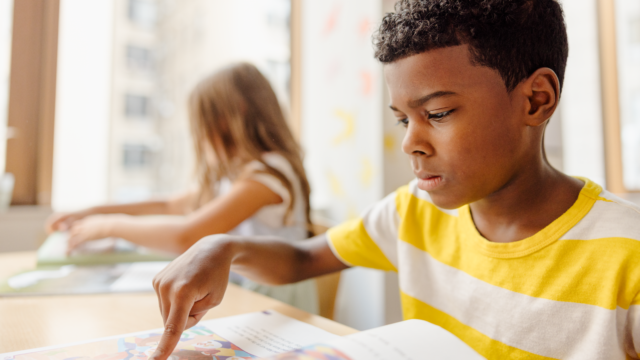
The popularity of the Notice & Note strategies for close reading continues to grow among teachers across the country. That’s because so many teachers find that their students read more closely and have better discussions when they use these strategies.
At the heart of Notice & Note are the signposts. Kylene Beers and Robert Probst, the Notice & Note originators, spent years studying the common features of fiction and nonfiction texts that help students understand and engage with their reading. Then Beers and Probst worked with students and teachers in the classrooms to refine the list of features to include only the most helpful, as shown below.
Each of the Notice & Note signposts for fiction and nonfiction has an associated anchor question. When students learn to identify the signposts as they read and ask themselves the question, they think more deeply about the author’s choices and the meaning of the text.
What are the 6 signposts in reading fiction?
- Contrasts and Contradictions
- Aha Moment
- Tough Questions
- Words of the Wiser
- Again and Again
- Memory Moment
What are the 5 signposts in reading nonfiction?
- Contrasts and Contradictions
- Extreme or Absolute Language
- Numbers and Stats
- Quoted Words
- Word Gaps
Notice & Note strategies and examples
Signposts can be used successfully with the simplest picture books as well as the most sophisticated works of literature, so it’s never too early or late in the learning journey to introduce them to students. But how do you begin?
1. Introduce the concept
Giving students some high-level information is a good idea. Try telling them: “Two reading experts studied hundreds of texts and identified common elements that give clues to meaning. We’re going to be looking for these and talking about them all year.” Some teachers give students a bookmark listing all the signposts that they can refer to as they read.
Resource for teachers: HMH Into Literature contains printable signposts bookmarks, plus a chart that some teachers laminate and distribute to students during small group discussions.

2. Start small
Even if you give students a bookmark or chart, you don’t have to explain all the signposts at once. That could be overwhelming. Decide on whether you are going to focus on fiction or nonfiction first. Start with one or two signposts at a time.
Beers and Probst suggest introducing the Contrasts and Contradictions signpost first, because texts often include several of these. Contrasts and Contradictions help students recognize character development, internal conflict, and more.
Next, you might want to move on to the Aha Moment signpost, which can help students identify how the character’s actions relate to the conflict, the progression of the plot, and sometimes the theme.
3. Define and describe
Make sure you clearly define the signpost you are focusing on, along with what the anchor question is and what noticing the signpost can help readers understand.
HMH Into Literature includes Peer Coach Videos for each signpost. Students enjoy having someone their own age explain the signpost and give some basic examples.
4. Use Real-World Examples
Offer a real-world example to help make the concept concrete, and then ask students to offer some additional examples. For instance, when introducing Contrasts and Contradictions, you might want to say something like: “If your dog always greets you at the door with excitement, and then one day you come home and your dog doesn’t rush over to you, you’re likely to notice that behavior because it contrasts with what you expect. You might ask yourself: “Why is my dog doing that? You might start to worry that there’s a problem.”
5. Reinforce with Visuals
Provide students with visual reminders of the signposts you’ve discussed by displaying anchor charts or sharing slides. You can create these charts with students as a whole-class activity or use some of the many pre-made resources available.
Resource for teachers: HMH Into Reading and HMH Into Literature provide printable anchor charts to display.

Resource for teachers: HMH Into Literature provides the anchor charts in both PDF and slide format.

6. Model and apply
When you introduce students to a new signpost, choose a text example and model how you identify the signpost while you’re reading and what your own thought process is. Tell students what words or phrases gave you a clue to the signpost. Note what the signpost is and explain why it fits the definition.
Pose the anchor question and ask students to give possible answers before explaining your own thinking. As you continue reading, release parts of this process to the students until they are spotting signposts on their own.
Resource for teachers: The HMH Into Reading Program Guide provides a table that shows where the Notice & Note signposts appear with texts. The Teacher’s Guide for each module includes a lesson on a targeted signpost.

7. Move toward independence
As students continue to practice Notice & Note strategies, they will start identifying literary signposts independently. Encourage them to do so by having a board where they can post examples they find. Invite them to respond to texts by writing about one or more signposts the notice in their reading. You will likely find that once students have grown comfortable noticing the six signposts in fiction or nonfiction, they engage more fully in their reading and ELA class discussions.
Resource for teachers: HMH Into Literature provides writing frames that can support students as they write about the signposts in reading.

***
Explore HMH literacy solutions with these digital samples of HMH Into Reading and HMH Into Literature.
This blog, originally published in 2021, has been updated for 2025.
Get tips to boost student engagement in your school with our FREE ebook.












